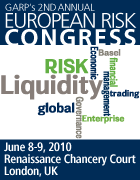Following the keynote address by Susan Schmidt Bries, a panel of experts convened to ruminate on the concept, "Executive Risk Managers - The CRO Perpsective."
Panelists included moderator Aaron Brown , CRO at AQR Capital Management; Ken Abbott, Managing Director at Morgan Stanley; Lawrence Prybylski, Partner at Ernst & Young; Dan Rodriguez, CRO at Credit Suisse; and Ken Winston, CRO at Western Asset Management.
Here are some of the highlights:
Aaron Brown: Which risk management tools proved their worth over the past couple of years? Which did not?
Winston: VaR is a normal market tool, and for commodity markets VaR did its job - a 99% success rate. In other arenas, however, it fell short. What is the optimal time window, to examine, for example? VaR proved problematic because of the uncertainty of the answer.
Also, stress testing fell short because of unanticipated shocks. Winston likes of idea stress-testing/VaR calculations in Monte Carlo frameworks.
Rodriguez: VaR keeps you distracted from tails. You need to focus on tail risks. Be dynamic in your view to see where you can get hit.
Winston: VaR = worthless and pernicious. Large operations waste time with VaR and they distract from real risks. VaR does not encourage diversification, rather it encourages tail risk. Co-variances from one period cannot be used in another period. Scenario analysis is too variant to account for fat tail risk. Risk managers need deep knowledge of markets and quantitative tools.
Brown: Are risk managers worthless because they did not predict the crisis?
Winston: The question has the premise that the job of risk managers is to predict unforseen hazards. This is very difficult, and predictions could have been better. There was a failure in managing rather than predicting risks. Types of qualitative measures should be used as well.
Rodriguez: Risk managers use a dynamic, evolving view. They must synthesize information, have an awareness of uncertaintity (e.g. regulatory). Across the industry, risk managers could have performed better. Agrees that qualitative information and analysis should also be incorporated.
Prybylski: Risk managers did not have a seat at the table in strategic thinking and planning. Moving forward, risk managers will not be isolated from Boards, product design, long term strategies, etc.
Brown: On regulations, which are good and which should we watch?
Prybylski: Positive elements coming from regulators and supervisors include FSB Publications of best practices. Also, pushing Boards to get more pro-active and forcing conversations with risk managers.
Unfortunately, firms are struggling with how to deal with liquidity risks. Risk managers are aware of regulatory uncertaintity and the implications for organizations. Companies are in states of impasse - resolution of this is important.
Brown: On the appointment of a systemic risk regulator, is this positive or negative idea?
Rodriguez: He likes the potential of reinforcing the Federal Reserve with potential system risk regulators. It's too early to tell, near-term effectiveness is a fantasy. He is not hopeful that regulation will pass anytime soon.
Winston: Systemic risk is being created by uncertainty across the industry over what will happen. A great deal of risk still exists.
And that's that!
Up next: enterprise risk management
Wednesday, February 10, 2010
Subscribe to:
Post Comments (Atom)






0 comments:
Post a Comment